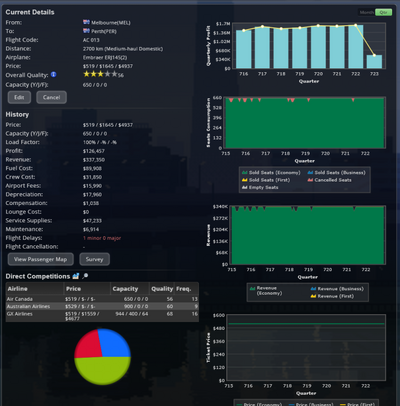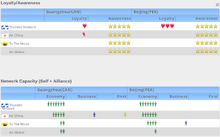(more info) Tag: Visual edit |
Tag: Source edit |
||
| Line 66: | Line 66: | ||
=== Frequency Cap === |
=== Frequency Cap === |
||
Each time you upgrade a [[Airport|base]], you increase the amount of flights per week you can negotiate for. Exceeding the limit will make the negotiations progressively harder. You can see the exact data in the table below. |
Each time you upgrade a [[Airport|base]], you increase the amount of flights per week you can negotiate for. Exceeding the limit will make the negotiations progressively harder. You can see the exact data in the table below. |
||
| − | {| class="article-table mw-collapsible mw-collapsed" |
+ | {| class="article-table mw-collapsible mw-collapsed" width="100%" |
|+Frequency Capacity per Base Level |
|+Frequency Capacity per Base Level |
||
!Hub Level |
!Hub Level |
||
Revision as of 05:45, 3 May 2021
A route is what the airlines use to make money off of their airplanes. To access a route, click on a line on the world map, or go to the routes menu and select a route from there.
On the page

An example of a route detail page, graciously provided by Air Canada.
The route details page has lots of information to take in, so here is a breakdown:
Current Details (Top Left)
This part of the details page describes the current details about the route.
- Departure and Arrival Locations- Gives you the country, city/town, and IATA code of the airport pairs.
- Flight code- These are generated in the order you make a route. If you delete a route (or multiple), those numbers will be reused.
- Distance- Length of the route in km and classification (see below).
- AIrplane- Model of the airplane that is being used, and how many planes are on the route (number in parentheses).
- Quality- Route quality, determined by fleet age on the route, service star on the route, and overall service quality.
- Capacity- Shows how many Economy/Business/First class passengers you can have on the route, or future capacity of undelivered planes. Does not include last cycle's amount of passenger limit (see below).
- Edit/Cancel button- Opens the route edit screen, or closes the route details page.
History (Center Left)
Gives information about what route Some of these are useful for troubleshooting your routes when they don't yield expected results.
- Price- Ticket prices from last cycle.
- Capacity- Maximum amount of passengers yout route could hold. Not to be confused with the capacity in the top left section.
- Load Factor (LF)- Percentage of the capacity that was filled. Simply multiply the Capacity amount by the percentage (or move the decimal point over to the left two places) and round, to find out the amount of passengers that are transported.
- Profit/Revenue- Revenue is the money made by the flight (Passengers times Price), and Profit is the money made after costs are subtracted.
- Fuel/Cew/Airport/Depreciation/Compensation/Lounge Cost/Service Supplies/Maintenance Costs- Costs that reduce the Revenue into Profit.
- Flight Delays/Cancellations- Delays add Compensation fees, Cancellations reduce the passengers for that week. Becomes more often with older planes, but delays are still possible with newer aircraft (not counting 100% planes).

Example of the Rival Details page.
There are two icons next to the title: a graph and a magnifying glass. The graph gives the competitor's history of capacity and ticket prices. Rival Details shows you and your rival's Loyalty/Awareness, and the network capcity.
Direct Competitions (Bottom Left)
This part gives information about your competitors on the route. It shows their Name, Prices, Capacity, Quality, and Frequency.
Graphs (Right)
The right side are graphs that show Profits, Seat Consumptions (how many seats were sold), Revenue breakdown, and ticket price history (from top to bottom). You can toggle between monthly and quarterly information.
Details
Categories
Routes fall into different categories based on length and where they're going. They determine how many staff are used per route, and the capacity you can sustain before routes become harder to negotiate.
Domestic Routes
Routes that go from one airport to another in the same country will be classified as Domestic routes. For example, a flight from Berlin to Düsseldorf would be a Domestic route, as they are both airports in Germany. Overseas territories (Guam, Réunion, Bermuda, etc.) are considered to be seperate entities and will not count as domestic routes.
- Routes less than 1,000 km in length are Short-haul Domestic. They fall under Frequency Cap I.
- Routes 1,000 km to 2,999 km in length are Medium-haul Domestic. They fall under Frequency Cap II.
- Routes more than 3,000 km in length are Long-haul Domestic. They fall under Frequency Cap II.
International Routes
Routes that start and end in airports from two different countries and are on the same continent would be classified as International. For example, flights from Bogotá to Buenos Aires are considered to be International (Colombia to Argentina).
- Routes less than 2,000 km in length are Short-haul International. They fall under Frequency Cap II.
- Routes 2,000 km to 3,999 km in length are Medium-haul International. They fall under Frequency Cap III.
- Routes 4,000 km or more in length are Long-haul International. They fall under Frequency Cap III.
Intercontinental Routes
Routes that start and end in airports on different continents are Intercontinental routes. For example, New York to Hong Kong would be an Intercontinental route (North America to Asia).
- Routes less than 2,000 km in length are Short-haul Intercontinental. They fall under Frequency Cap II.
- Routes 2,000 km to 4,999 km in length are Medium-haul Intercontinental. They fall under Frequency Cap III.
- Routes 5,000 km to 11,999 km in length are Long-haul Intercontinental. They fall under Frequency Cap III.
- Routes over 12,0000 km in length are Ultra long-haul Intercontinental. They fall under Frequency Cap III.
Airports near the continent borders such as ELE-APO (Panama-Colombia) can be classified as Short-haul Intercontinental, as they are from North America to South America. However, domestic routes always take over Intercontinental. For example, SVO-VVO (Moscow-Vladivostok, which are both in Russia, but Vladivostok is in Asia and Moscow is in Europe) is a Long-haul domestic instead of a Long-haul Intercontinental.
Frequency Cap
Each time you upgrade a base, you increase the amount of flights per week you can negotiate for. Exceeding the limit will make the negotiations progressively harder. You can see the exact data in the table below.
| Hub Level | Cap I | Cap II | Cap III |
|---|---|---|---|
| 1 | 6 | 7 | 7 |
| 2 | 9 | 9 | 9 |
| 3 | 11 | 11 | 10 |
| 4 | 14 | 13 | 12 |
| 5 | 16 | 15 | 13 |
| 6 | 19 | 17 | 15 |
| 7 | 21 | 19 | 16 |
| 8 | 25 | 22 | 19 |
| 9 | 28 | 25 | 21 |
| 10 | 32 | 28 | 24 |
| 11 | 35 | 31 | 26 |
| 12 | 39 | 34 | 29 |
| 13 | 42 | 37 | 31 |
| 14 | 46 | 40 | 34 |
| 15 | 49 | 43 | 36 |
